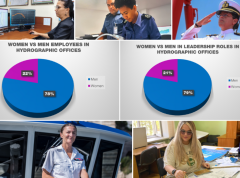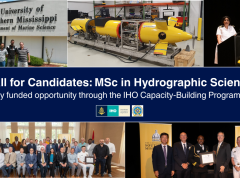S-52 Portrayal Bulletins
Introduction
S-52 provides specifications and guidance regarding the issuing and updating of Electronic Navigational Charts (ENC), and their display in ECDIS. This IHO Publication was developed in conjunction with the IMO Performance Standards for Electronic Chart Display and Information System (ECDIS).
The S-52 Chart Presentation Bulletins are placed here to communicate information concerning portrayal and update issues related to ECDIS and ENC production. They may influence ENC producers´ encoding practices and should be consulted in conjunction with the S-57 Encoding Bulletins. Each Bulletin explains a particular ECDIS portrayal issue, recommended procedures for addressing the issue and the consequences of not following the recommended procedures.
NOTE: all changes described in S-52 Bulletins are strong recommendations and do NOT override existing IMO, IHO nor IEC related standards or specifications.
PB1 - S-52-CPB-No 1: S-57 encoding of FSPT/USAG (CSMWG14 Action 31)
In very rare cases a depth (DEPARE) or dredged area (DRGARE) boundary may coincide exactly with a cell boundary. Encoding nations should be aware that in this case, a break or gap will appear in the safety contour along that part of the cell boundary. It should be noted that alarms or indications will still be generated for the DEPARE or DRGARE in this situation.
PB2 - S-52-CPB-No 2: New S-52 conditional symbol procedure (CSP) for WRECKS (CSMWG14 Action 32)
PresLib Edition3.3 includes changes to the CSP for wrecks. As the depths of tankers have increased in recent years up to 35 metres, this CSP does not take into account CATWRK = 1 (non-dangerous). When no VALSOU is provided, the new CSP now calculates a value for VALSOU using the formula in M-4 B-422.7 (original version). It was suggested by the CSMWG that better encoding of wrecks (including the population of VALSOU when possible) must be the responsibility of the encoding HOs. ENC encoders will be encouraged to provide an estimated depth or safe clearance for all wrecks.
PB3 - S-52 CPB-No 3: Linear depth areas (CHRIS17 Action)
Following the release of the new S-52 Presentation Library edition 3.3 in March 2004, ECDIS manufacturers were given until 1 Jan 2006 to instigate the revised presentation library. Due to an uncovered mistake in the CSP which detects the safety contour, CHRIS17 (in 2005) agreed to postpone the implementation of the updated Presentation Library until 1 Jan 2007 because the correction of the affected CSP is expected to be available towards the end of 2006. For the time being, the encoding of linear depth areas (DEPARE) will be continued to feed ECDISes in the field, which are not updated to the new detection method yet. A new date for termination of encoding of linear depth areas will be forwarded by the IHB in due course.
PB4 - S-52-CPB-No 6: Portrayal of flood lights, strip lights and spot lights
The S-52 Presentation Library Edition 3.3 (March 2004) and the Edition 3.4 (January 2008) do not portray flood lights, strip lights nor spot lights (CATLIT 8, 9 and 11 respectively).
PB5 - S-52-CPB-No 7: Chart 1: Corrected files and images
The IHO Presentation Library for ECDIS (Annex A to S-52 Appendix 2) includes, in its edition 3.4 (January 2008), data files called Chart 1 and printouts in alphabetical and numerical order of all objects. As it came to practical application, a number of minor mistakes have been detected within the Chart 1 data files and in the screen shots included in Part I of PresLib e3.4.
PB6 - S-52-CPB-No 8: Equal placement of depth contour labels (CSMWG18 Action 16)
Depth contour lines are often coded in segments of equal status with varying run lengths. Short contour segments are sometimes not optimal for the presentation of contour labels if the generic rules of DPCNT03 are too strictly applied. Therefore, the interpretation of DEPCNT03 rules to display depth contour labels should be interpreted in a way, that it results in an equal spaced placement of the labels with a distance which is independent from the fraction of the contour into segments and fits well to the selected display scale.
PB7 - S-52-CPB-No 9: Definition of navigation symbology contained in IEC62288 (CSMWG18 Action 19)
IEC Standard 62288: Presentation of navigation-related information on shipborne navigational displays provides the guidelines for the presentation of navigation-related symbols, terms and abbreviations originally described in Safety of Navigation Circular SN/Circ. 243 together with some requirements published in resolution MSC.192(79) on radar and resolution MSC.232(79) on revised Performance Standards for ECDIS; and MSC/Circ. 982 on Guidelines on ergonomic criteria for bridge equipment and layout. IEC62288 replaces Annex E of IEC 61174 for navigational symbols including AIS-symbols used in stand-alone ECDIS displays.
Although the Presentation Library and its updates endeavour to reproduce all current non-chart symbology, IEC definitions in IEC standards 61174 and 62288, IMO directions for AIS display and other future technologies remain the authority for navigational symbols, and their latest editions should always be consulted. It has to be noted that IEC 62288 does not relate navigational symbols to specific colours. In the interest of safe navigation, through ensuring that symbology for navigational and for chart information are consistent with each other, all non-chart symbology reproduced in the Presentation Library is added by colour tokens belonging to the colour model of S-52, Appendix 2.
PB8 - S-52-CPB-No 10: Portrayal of virtual AIS aids to navigation (HSSC4 Action 16)
Also included as EB54 -UOC Clause 12.14.1 AIS equipment aids to navigation




Share this page: